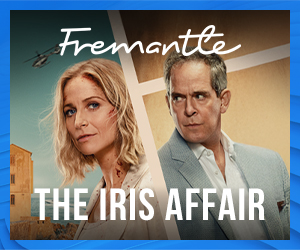
Erik Matti, one of Asia’s best known filmmakers and winner of last year’s ContentAsia Award for Best Director, talks about his latest award-winning project, "On the Job", and the win-win that maximised cinema and mainstream TV screens.
Erik Matti’s high-profile Filipino crime thriller, "On the Job", has a deliciously complicated back story.
Eight years after two episodes debuted as a feature film in Cannes, the latest version – On the Job: The Missing 8 – premiered in September this year at the 78th annual Venice International Film Festival, the only Asian film screening in the competition. The feature won the Volpi Cup Best Actor Award for John Arcilla, who plays corrupt newspaper reporter Sisoy Salas.
Two days later, a six-episode premium series, with previously unseen and remastered footage, debuted on HBO Go across Southeast Asia, Hong Kong Kong and Taiwan.
Inspired by true events, the original On The Job centres around crime syndicates, controlled behind the scenes by sitting politicians who release prison inmates to carry out political assassinations.
Matti is open about domestic feedback to his idea in the early days; he started pitching it around 2010 and the response was pretty much ‘no way’. “It was a strange time in the Philippines,“ he says. ”We hadn’t been doing that kind of a film back then. So we never got the popularity”.
Three years later, in 2013, the first feature was produced by Matti’s Reality Entertainment with the Philippines’ Star Cinema, and had its world premiere in Cannes as part of the Directors’ Fortnight. Written by Matti and Michiko Yamamoto, the film stars Gerald Anderson and Joel Torre as two hitmen, and Piolo Pascual and Joey Marquez as law enforcement officers.
Winner of the ContentAsia Award for Best Director in 2020, Matti takes us behind the scenes of On The Job, a bold, multi-faceted production with many incarnations and which now screens and streams in a very different social, political and entertainment environment.
You’ve said On the Job is about more than assassins and prisoners being brought out of prison to kill. How much more?
“We wanted a film that would tackle the difficulties, the moral decisions, that people make on the job. So, in the case of the first film, in addition to the story of the prisoners, there’s also the story of the policemen and their difficulty in finding the killers because they are alr...
Erik Matti, one of Asia’s best known filmmakers and winner of last year’s ContentAsia Award for Best Director, talks about his latest award-winning project, "On the Job", and the win-win that maximised cinema and mainstream TV screens.
Erik Matti’s high-profile Filipino crime thriller, "On the Job", has a deliciously complicated back story.
Eight years after two episodes debuted as a feature film in Cannes, the latest version – On the Job: The Missing 8 – premiered in September this year at the 78th annual Venice International Film Festival, the only Asian film screening in the competition. The feature won the Volpi Cup Best Actor Award for John Arcilla, who plays corrupt newspaper reporter Sisoy Salas.
Two days later, a six-episode premium series, with previously unseen and remastered footage, debuted on HBO Go across Southeast Asia, Hong Kong Kong and Taiwan.
Inspired by true events, the original On The Job centres around crime syndicates, controlled behind the scenes by sitting politicians who release prison inmates to carry out political assassinations.
Matti is open about domestic feedback to his idea in the early days; he started pitching it around 2010 and the response was pretty much ‘no way’. “It was a strange time in the Philippines,“ he says. ”We hadn’t been doing that kind of a film back then. So we never got the popularity”.
Three years later, in 2013, the first feature was produced by Matti’s Reality Entertainment with the Philippines’ Star Cinema, and had its world premiere in Cannes as part of the Directors’ Fortnight. Written by Matti and Michiko Yamamoto, the film stars Gerald Anderson and Joel Torre as two hitmen, and Piolo Pascual and Joey Marquez as law enforcement officers.
Winner of the ContentAsia Award for Best Director in 2020, Matti takes us behind the scenes of On The Job, a bold, multi-faceted production with many incarnations and which now screens and streams in a very different social, political and entertainment environment.
You’ve said On the Job is about more than assassins and prisoners being brought out of prison to kill. How much more?
“We wanted a film that would tackle the difficulties, the moral decisions, that people make on the job. So, in the case of the first film, in addition to the story of the prisoners, there’s also the story of the policemen and their difficulty in finding the killers because they are already back in prison. There’s also the politics, and the moral grey areas and dilemmas, getting into the crossroads of what is right or what is wrong... so it becomes even more interesting and layers the whole film as opposed to just another bang-bang movie.
For the second version, we didn’t want to just mimic the first one and do another story that kind of looks familiar, with the same structure and tone as the first one. So we dug deeper. When we started writing this four years ago, I was really interested in how the news cycle had changed because of the internet, because of social media and how TV, newspapers and even social media affect certain issues that are in the foreground of government or a country. And with this new story, we chose journalism as the job to zero in on and dissect.”
Why did you chose journalism as the central job in the second version?
“We started thinking about this around the time that the Cambridge Analytica scandal emerged, and we found out that the Philippines was Cambridge Analytica’s first testing ground, before Trump used it for the U.S. elections. That started the whole idea of how stories could change with the use of media. We wanted to show what goes on behind the scenes of a big event, which is totally opposite of what’s in the news.”
Your On the Job journey has run for more than eight years, with festival releases, lots of remastering for film and TV, and different versions of the story. What’s that been like?
“The first On the Job, way back in 2013, was done on HD. Right now films are output in 2K or 4K. We regraded and remastered the whole film into 2K, and fixed some of the visual effects. In 2K, you get more clarity, you can see the seams of the visual effects. So we cleaned it up a bit more and adjusted the colour to make it a little more modern, because the first one had stronger, more saturated colours. That was typical of films back then, of influences of the kind of films that were coming out during that time. Now colours are a bit more subtle, simpler, not too in-your-face and that also allowed me to link the colours of the first one to the second one ... if you’re bringing the whole thing from 1 to 6, you get to see an uninterrupted colour palette as you move on from one episode to the next.”
You also brought in a whole lot of footage and plot points that were left out of the first version...
“Back then I wanted a longer film. I shot a whole lot of footage for the movie. But since it’s a movie and we know how difficult it is to release a film that goes beyond two hours in our cinema circuit, I ended up taking out some of the plot points and just focusing on the main thread of the film.
And of course, later on, we went into On the Job 2; the new film runs for three hours and 28 minutes because I wanted to bring in all the plot points. I wanted to tell the entire story. That allowed me to use it for a series.
When you go into a series you’re allowed to linger a little more on character nuance and stories... because it’s episodic, viewers tend to be a little more patient. Looking at it as a series made it interesting. The extra plot points worked.
For the series, we included the first movie because the first movie ended exactly where the second film starts. So it’s just a nice viewing experience to see the first one, where it all started and then continuing into the new installment.”
Have you ever done anything like this before? Take two movies and turned them into a TV series?
“No. But I think the pandemic does a lot of things to all of us. When we finished the film last year, we were really confused. We didn’t know where to bring it. It’s not a popcorn film and cinemas were closed. And it’s not easy to sell a three-hour-28-minute film.
“Before my fellow co-producers even saw it, I was already thinking of how I can sell the whole idea without them saying, ‘Oh my God, Matti you did a three-hour-28-minute film, where are we going to show it in this pandemic’, right?
So prior to them seeing the film, I had a three-hour-28-minute cut. Together with that, I already did the presentation where I could turn it into series and by hearing that, their viewing experience of the three hours and 28 minutes was really a breeze. They had fun watching it because now they have options as to where we could bring the film.
As much as I really want the film to be seen in its entirety in one go, things just aren’t just on our side in this time of pandemic and the next question there is: ‘do you just want people to see your film?’ Even if you divide it into several episodes, just so it can get more eyeballs, right? So that’s what we ended up with. And so far we’re happy.
“I think this is a major thing not just for me, or for our company. It’s a major thing for Philippines as a whole, for the filmmakers of the Philippines, because not only did we make it in Venice, we were able to sell the film and turn it into something that could make money and could be put into commercial use.
“So that’s a win-win. Most of the time when you do films, they either go into the art house or only to mainstream platforms. And this one, win-win. We get the best of both worlds.”
And talking about the best of, you won a ContentAsia Award last year for your contribution to HBO’s Food Lore and you’re involved in the second season of Folklore. Can you tell us about what you’re thinking?
“For Food Lore, we were representing the Philippines food legacy in a way. The first thought that came to mind, before we even came up with the story, is what unique Philippines food idea or insight do I want to share with the international community.
“That’s where the idea of the fiesta came in, because fiestas are really Spanish-born and not a lot of countries in Southeast Asia have fiestas. They have celebrations, of course, but not the kind of Spanish influence that we have here. And also, where our food is mainly used as survival. Everyone starts with survival and we develop our palates from there. So the idea of an overseas worker started with what kind of character could we pick who international audiences could relate to. And of course, almost all Asian countries have a lot of Filipino overseas foreign workers. So they get the idea of someone coming home from overseas work.
In the same way, in the second one, in Folklore, we thought of what’s really distinct for the Philippines, in terms of its folklore. And we picked black magic – in some countries, it’s called voodoo – because we’re very superstitious and there’s a lot of that even in modern society, even in the cities, there are a lot of stories about sickness that is not really explained through science immediately, it’s just explained through supernatural effects. So that’s where we started.
We also tackle the story of justice. The main protagonist is a police woman and her family is conflicted because the son has a sickness and with that sickness, she is now torn between being a policewoman, usually reliant on evidence and proof, and dealing with the sickness of the son, which science could not explain because it’s coming from something supernatural. So it’s an interesting story. Of course, there are scary parts, but really it’s a character story of the policewoman.”
Is this authentic Filipino heart and soul something that you focus on in all your moviemaking?
“Yes. I think early on, I wanted to root my films in something very Filipino, but having a really universal story. I think right now the boundaries in films, not just films, even TV, even online, even online content, the boundaries have been blurred. You make stories not just for your country of origin, but you make stories for everyone to see and for everyone to understand.
“I think if you keep the balance really well, you can come up with something very, very true to your country of origin, but it’s something that somebody from Norway could easily identify with, or somewhere in Latin America could identify with. And I’ve always tried to make stories based on that.”
Published in ContentAsia October 2021 Magazine
























